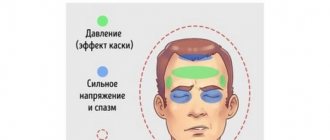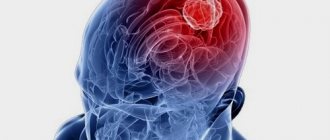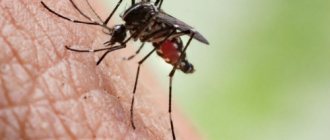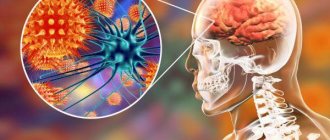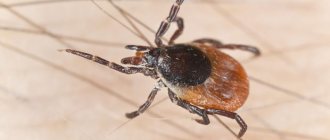Tick-borne encephalitis is an infectious pathology that belongs to the natural focal group. The main carrier of the virus is encephalitis ticks (Ixodespersulcatus and Ixodesricinus), which live in nature. After infection, extracellular agents cause severe intoxication of the body, affecting the central nervous system, spinal cord and brain of a person. With severe dynamics, the pathology has more dire consequences, including death. To prevent and reduce the negative impact of encephalitis, it is worth familiarizing yourself with this disease in more detail, as well as learning methods for its treatment and prevention.
General description of the disease
The causative agent of encephalitis is flaviviruses. The structure of the virion consists of microscopic spherical particles, on the surfaces of which there are spike-like projections. The structure of the virus includes a nucleocapsid acid and one protein shell (capsid).
The virion size is about 50 nm, which is several times smaller than influenza and measles viruses. This feature allows the causative agent of encephalitis to easily penetrate the human body, bypassing all barriers of the immune system.
Habitat of encephalitis ticks
In nature, viral extracellular agents are found in the body of ixodid arthropod ticks. Their sphere of life is forest or forest-steppe. Main foci of infection:
- Ural;
- Siberia;
- Mongolia;
- Far East;
- China.
According to statistics, the most dangerous region is the Far East, where 20-40% of deaths were recorded. In Russia this figure is much lower, amounting to only 1-3%.
Based on their habitat, the encephalitis carrier is divided into two groups:
- taiga tick (Ixodes Persulcatus);
- European tick (Ixodes Ricinus).
The first type has a monochromatic black color. The European tick is characterized by a straight base of its proboscis.
The tick-borne encephalitis virus is able to maintain its current state when dried out and at low ambient temperatures. However, it is unstable at room temperature and dies when boiled.
Routes of transmission of encephalitis
An outbreak of infection with tick-borne encephalitis occurs in the spring and summer. At this time, female insects are in dire need of feeding with blood to ensure the process of fertilization and development of eggs. Rising from the forest floor, the pests crawl through the grass and bushes in search of a warm-blooded animal or person. As soon as the feeding object is close, the insects pounce and cling to the living organism. After sucking, the encephalitis carrier begins to drink blood for 6 days, then falls off to lay eggs and dies.
As practice has shown, infection with encephalitis occurs while feeding an insect through its saliva. However, there are other cases in which the disease enters the human body.
Ways of transmission of infection:
- By consuming raw milk from an infected animal.
- If you scratch an area of skin where tick feces are present.
- Through saliva during the bite of a sick animal.
It is worth noting that the virus is not transmitted through household contact. Therefore, an infected person does not pose a threat to others.
Routes of infection
It is possible for a person to become infected with tick-borne encephalitis in the following cases:
- bite by a wild animal;
- transmission from birds or rodents, which are the primary sources of the virus.
Now in more detail about this.
The virus is transmitted, as mentioned above, by ticks. How do the bugs themselves become infected with encephalitis? It enters their body through the blood of the animal whose blood they feed on. And then the virus remains with the tick for life, and is also inherited. There are two ways to infect a person with the tick-borne encephalitis virus: transmissible and nutritional, and they do not differ from how ticks themselves become infected with encephalitis.
The first method is the main one. Since the largest accumulation of the virus occurs in the salivary glands of the tick, by clinging to human skin, the infected insect transmits the virus into the blood in this way.
According to SanPIN, human infection with tick-borne encephalitis is also possible in a second way: nutritional, which is quite rare. It occurs through the human gastrointestinal tract when consuming unboiled milk from a cow or goat that has been infected with tick-borne encephalitis.
There is another rather rare variant of infection: if you try to crush a tick, its saliva gets onto the human mucous membranes, as well as into microcracks in the skin. It is very important to know the amount of time for which the tick has been attached, because you need to remove it as quickly as possible. Yes, everyone’s body is different, so people’s reactions to the tick-borne encephalitis virus entering the blood can vary greatly.
For example, a person living in an area where ticks are active may develop antibodies as a result of frequent but short-term bites. Then, if infection occurs, the disease will be milder and end faster. Signs of infection with tick-borne encephalitis in this case will be less pronounced and will not greatly disturb the sick person.
There is also the so-called “Japanese” encephalitis. It is also called “mosquito virus” due to the fact that mosquitoes are carriers of this virus. People who spend a lot of time outside, especially in the evening, are at greater risk of becoming infected than others. This virus is found in almost all countries. It spreads through mosquito bites. Children are most often infected.
Since mosquitoes bite not only people, but also animals, they can become carriers of this type of virus.
Incubation period
The incubation period, which lasts from the moment of infection until the appearance of the first signs of the disease, is individual for each person. Its duration depends on the following factors:
- cause of illness;
- whether you were vaccinated against tick-borne encephalitis in childhood.
If infection occurs through the bite of an insect or a sick animal, the first signs of the disease appear after 2 weeks. When consuming unpasteurized milk from infected cattle, the incubation period ranges from 3 to 7 days.
If the child was vaccinated in childhood, the delay in identifying the disease may last more than 1 month.
Cases of fulminant disease have been identified, when a day after infection a person fell into a coma or died.
Pathogenesis
The localization of the causative agent of the disease can be in the digestive system, saliva and genital organs of insects.
After the virus enters the body, infection of the body occurs as follows:
- Encephalitis passes through the first barrier of the digestive system, or the subcutaneous layer.
- Having identified harmful cells, the body begins to produce macrophages.
- The antibodies produced do not cope with infectious agents, but contribute to the proliferation of antigens.
- After reproducing its own kind, the virus moves to the lymphatic system.
- Then the infection spreads through the blood vessels to the internal organs and nervous system.
In the nervous system, the virus destroys the gray matter and connective structures of the brain and spinal cord. Acute encephalitis can damage the respiratory and gastrointestinal tract.
General symptoms of the disease
In 15% of cases after infection, people do not observe any precursors of the disease, or the symptoms occur in a nonspecific form, in which it is difficult to determine encephalitis. Such an incubation period is quite dangerous, as it can lead to more serious consequences. In other cases, the symptoms of tick-borne encephalitis occur in the same way in all adults.
Primary symptoms of infection:
- sleep disturbance;
- general weakness of the body;
- fast fatiguability;
- pain in the eyes;
- nausea;
- mental disorders.
There is also body aches in areas such as the arms, shoulders, legs and certain areas of the back. An adult can tolerate these symptoms quite easily. In young children, the disease develops rapidly and is more severe.
Symptoms of the disease in an advanced stage in a small child and an adult:
- a sharp increase in body temperature to 38-40 degrees;
- chills and fever have been observed for more than one week;
- frequent urge to vomit;
- severe headaches;
- double vision;
- impaired coordination of movements;
- inhibition of behavior;
- redness of the entire face and neck up to the collarbone;
- tearfulness of the eyes.
In addition, the patient suffers from seizures due to irritation of neurons. The disease can occur in several forms, which depend on the subtype of tick-borne encephalitis and its location.
How does a person become infected?
[ads-pc-1]Not only large animals, but also humans can become tick prey. Tick activity begins to appear in early spring, so encounters with these creatures are possible as early as April. The peak of activity occurs in May (you need to be careful when going on picnics in May) and lasts almost until the end of June. With the onset of dry and hot days, activity decreases.
The European part of Russia is characterized by a second August peak. In the Urals, Siberia and the Far East, there is only one spring-summer peak. Tick-borne encephalitis has two sources of transmission of the virus to humans:
- taiga tick (found in taiga forests of Siberia and the Far East);
- canine (range: European part of Russia, Central and Northern Europe).
Russia ranks among the first in the world in terms of the number of cases of disease. 20–30% of cases are children.
Photo of attached ticks
Tick-borne encephalitis can be contracted unnoticed. Having found a secluded place with thin skin, the tick bites through the skin with its chelicerae and inserts into the wound a proboscis with chitinous teeth that reliably, like an anchor, hold the animal’s body to the breadwinner. This is why it is difficult to remove a tick from a wound (learn how to do it yourself).
With saliva, substances that prevent blood clotting enter the wound, so animals can drink a lot of it. Painkillers are also injected into the wound, the bite turns out to be painless, a person does not always notice the small monsters attached to his skin. After the animals have drunk, they extend their proboscis and fall to the ground.
It is impossible to determine from the appearance of a tick whether it is infected with the encephalitis virus. It can be determined in the laboratory by making a sample.
Etiology
The etiology (causes), routes of infection and transmission of tick-borne encephalitis have been studied quite well. The infectious agent multiplies in the cells of mammals, birds and arthropods. It does not live long in the external environment and is quickly destroyed by boiling and the action of disinfectants. Tick-borne encephalitis is characterized by natural focality - the disease occurs only where ixodid ticks live.
Infection with encephalitis occurs through consumption of raw milk and other dairy products obtained from sick animals. Routes of infection: transmissible (through blood from a bite), nutritional. The gateway of infection is the skin, epithelium of the digestive tract. The virus moves through blood and lymphatic vessels, infecting cells and tissues on its way. Upon reaching the brain, it is localized in cells.
The disease is often acute; rarely, there is a chronic form that lasts for life. Complications that arise during the development of the disease can result in paralysis or death - in 70-80% of patients complications persist for life, in 20% the development of pathology ends in death.
Pathogenesis of the disease in humans
Tick-borne encephalitis is characterized by deep damage to the white and gray matter of the brain, sensory and motor roots of the spinal, cranial and peripheral nerves. In patients, the meninges swell and become hyperemic, and internal organs are affected - kidneys, liver, lungs. Irreversible processes of death of neurons and cerebral vessels occur.
The pathogenesis of encephalitis is varied:
Cerebral edema
- if the dose of the virus is insufficient, the disease does not develop,
- sometimes clinical symptoms do not appear, the disease proceeds latently;
- distinguish such forms as meningitis, meningoencephalitis, febrile forms, encephalomyelitis;
- According to another classification, a form with brain damage and a febrile form are distinguished.
All people who become ill with tick-borne encephalitis should be simultaneously examined for borreliosis, since ticks can be infected with both infections.
Clinic
The incubation period is 7-14 days, sometimes up to 20 days. The disease develops acutely, patients complain:
- for weakness, numbness of the skin of the neck and face, increased fatigue;
- temperature increase up to 40°C, hyperemia of the skin and mucous membranes;
- pain throughout the body, muscle pain;
- the occurrence of paresis and paralysis.
Stupidity, stupor, and coma may occur. If symptoms of the disease appear, the patient must be urgently taken to the infectious diseases department to clarify the diagnosis and carry out intensive drug treatment.
Forms of tick-borne encephalitis
In order to establish which forms of the tick-borne encephalitis virus have affected the nervous system, it is necessary to pay attention to which symptoms are more pronounced. In medical practice, according to classification, there are 6 main types of disease.
Feverish
The febrile form of the disease resembles common respiratory viral infections, which are characterized by the following symptoms:
- high body temperature;
- chills;
- weakness;
- constant headache.
As a rule, the infection is found only in the patient’s blood, without affecting the lining of the brain. In this regard, neurological disorders in this form of encephalitis are mild and can only be accompanied by body aches and goosebumps. The average course of treatment is 1 month, after which the patient begins to feel much better. In some cases, during the period of remission, phenomena such as poor appetite, rapid pulse, weakness and sweating may be observed.
Meningeal
This form of encephalitis occurs most often in medical practice. The first signs of the disease resemble meningitis, in which the main specific symptom is a severe headache when bending over. The patient also experiences the following pathological phenomena:
- dizziness;
- vomit;
- pain in the eyes;
- body temperature above 38 degrees;
- weakness in the body;
- inhibition in behavior.
Moreover, after a tick bite, the structures of the brain and spinal cord begin to be affected first. As a consequence, patients experience rigidity in the head muscles, due to which it loses stability and constantly tips in different directions. Also, a complication of the disease can lead to paralysis of a person’s upper and lower limbs, complicating or stopping their mobility.
Meningoencephalitic
This type of disease is characterized exclusively by brain damage. The symptoms of infection depend on its types, which are divided into diffuse and focal meningoencephalitis.
In the first case, the patient experiences the following disorders:
- lack of movement of facial muscles;
- decreased spatial orientation skills;
- tongue paralysis;
- hallucinations;
- swelling of the airways.
In the second form of the disease, a paralytic syndrome with profound personality disorder is observed.
Poliomyelitis
The spread of the encephalitis virus in the polio form occurs exclusively in the spinal cord. The initial stage of the disease is characterized by the following phenomena:
- fatigue;
- decreased mental activity;
- mental health disorders;
- inappropriate behavior.
After a couple of days, these symptoms change for the worse. Patients infected with mites begin to suffer from paralysis of facial muscles, impaired mental functioning and lack of skin sensitivity. In a more acute form, patients cannot control their movements and thoughts, or grasp the essence of a conversation. In addition, people experience a sharp decrease in muscle mass, which leads to dystrophy.
Polyradiculoneuritic
This type of pathology is quite dangerous to human health. It can affect all processes and roots of nerves outside the spinal cord and brain. The main symptoms of the disease are characterized by the following signs:
- muscle cramps throughout the body;
- tingling sensations on the surface of the skin;
- pain in the leg muscles;
- paralysis that covers the entire human body.
The peculiarity of this pathology is that it more often leads to death.
Dual wave
From the name you can understand that tick-borne encephalitis of this form occurs in two stages. The first wave of the disease begins immediately after infection. During this period, patients’ well-being changes dramatically, and the following symptoms begin to appear:
- dizziness;
- lack of appetite;
- drowsiness;
- gagging;
- aching limbs.
Then, within a week, the patient experiences a sharp increase in body temperature, along with chills and fever. After the specified time, a lull occurs in the human body, lasting about two weeks.
The second stage of pathology occurs in the most complex form. In addition to the above symptoms, the disease is characterized by the following signs:
- decreased orientation in space;
- headaches and lumbar pain;
- the occurrence of hallucinations.
As practice has shown, it is possible to recover from such a pathology in a short time. With timely diagnosis, a favorable outcome of the disease is guaranteed.
Biology of Ixodidae
Ixodid ticks (pasture or forest ticks) are small arachnids that spend part of their life on the host’s body and feed on the blood of humans and animals. Ticks have a small head, eight legs, a small body, and a sharp harpoon-shaped proboscis for sucking blood. They orient themselves using the organs of touch and smell, and are able to sense a warm-blooded organism at a distance of up to 10 meters.
The most voracious individual is the female, because she needs nutrients for the development of eggs. Having sucked blood, the female increases in size a hundred times, becoming like a large shiny droplet. But be careful - an awkward movement, and the abdomen may burst, and its contents may splash into the eyes or a wound on the body. Males are not so bloodthirsty - after all, they do not need to take care of their offspring, they just need to feed themselves and fertilize the female.
From an epidemiological point of view, female ticks will be the most dangerous. After sticking for several days, they, together with saliva, inject a large number of viral particles into the human blood.
Why are ixodid ticks dangerous for humans?
Horror stories about ticks have a real basis - you can become infected with such a terrible disease as borreliosis or encephalitis. How can a person become infected? It is enough to take a walk in nature, pick up a tick, the bloodthirsty creature will find a secluded place, pierce its head almost completely into the skin and drink and suck for ten to twelve days, if a person does not notice it earlier, or accidentally catches it, tearing off its bloody abdomen. But the job has already been done - the tick bite has triggered the mechanism of infection transmission.
True, not every close encounter with a tick can cause encephalitis; the animal must have this insidious active virus in its saliva. The number of bites from an encephalitic animal increases the risk of developing the disease, although sometimes one bite is sufficient. Timely vaccination and a sufficient level of antibodies are a guarantee that the disease will not develop. How ticks become infected, where the virus comes from, and the transmission mechanism is studied by the science of epidemiology.
How do ticks become infected?
The source of infection is mouse-like rodents (shrews, voles, shrews), moles, hares and other small animals. Epidemiologists have counted more than 200 animals that are natural reservoirs of the encephalitis virus. Natural foci of tick-borne encephalitis are the taiga regions of the Far East, the forest zone of Russia from Kaliningrad to Sakhalin.
The disease is characterized by spring-summer periodicity, with an increase in the activity of ticks, the number of infected people increases. Ticks become infected by feeding on the blood of these animals, often change 3-4 hosts, and have a complex life cycle:
- Fertile females lay a huge number of eggs, from which larvae develop.
- The larvae live on small animals, birds, and sometimes on large insects; before the onset of the next phase of development, they fall to the ground, turning into a nymph.
- A nymph is an immature tick that lives on large animals and humans; when fed, the nymph molts and also falls to the ground.
- After a while, the adult crawls onto blades of grass, sits with its paws spread, and waits for its “prey” - the owner.
Tick life cycle diagram
Adults live 3–4 months, die by autumn, only immature females overwinter.
Is it possible to cure encephalitis?
Every person, especially mothers of small children, wants to know whether encephalitis can be cured after the virus enters the body. There is no clear answer to this question. The fact is that the destruction of a pathogenic microorganism depends on the following factors:
- What type of tick-borne encephalitis spreader is it?
- How much time passed between infection and contacting a medical facility.
- How developed is the human immune system?
Mild forms of encephalitis can be eliminated within 3 months. Treatment for severe forms of the disease takes several years, and, according to official statistics, only 70% of patients survive.
An important factor in preventing the development of severe forms of encephalitis is the immune system. As a rule, urban residents, due to the environment, have lower levels of protective properties of the body. In this regard, they have a lower effectiveness of prescribed therapy than the rural population.
Everyone knows that any pathology is easier to prevent than to treat. Therefore, after contact with a tick, it is necessary to urgently contact a medical facility.
Diagnostics
A necessary condition for prescribing therapy is an accurate diagnosis. To create an overall picture that will confirm or refute the disease, a person undergoes a series of medical examinations.
Clinical diagnosis
A preliminary diagnosis in the case of encephalitis can be made by performing a clinical diagnosis. During this examination, the neurologist first listens to the patient's complaints. From the patient’s words, the doctor will find out whether there was direct contact with the tick, the estimated time of infection, and how the symptoms of the disease manifest themselves.
Next, a visual examination of the patient is performed. When affected areas of the skin are detected, the specialist begins to find out epidemiological data.
Epidemiological information
At this point, to screen out other pathologies, the neurologist collects the following information from the patient:
- Actual residential address.
- Climatic conditions of the region.
- How often does a person visit the forest?
- Lifestyle.
- Profession.
- What food have you eaten recently?
Also, to make a diagnosis, the patient will need to answer how the infection occurred, and whether there were attempts to remove the tick or whether it fell off on its own.
Lab tests
To diagnose tick-borne encephalitis, you will need to conduct laboratory tests and hardware procedures. A diagnosis can be made quickly and accurately by examining the tick itself. If this is not possible, the patient is prescribed the following diagnostic methods:
- Immunoassay. The use of this method will make it possible to detect antibodies to the encephalitis virus in the patient’s blood. The presence of class M glycoproteins will indicate that the patient became infected with a vector infection not so long ago. If immunoglobulin G is observed in the blood serum, it means that the person has already suffered from encephalitis in his life.
- CT scan. With this method, the patient's brain is examined. A computer image will show the presence of the inflammatory process, its severity, as well as which areas are affected by encephalitis.
If, after a complete diagnosis, an insect infection is confirmed in the patient, he is prescribed appropriate therapy.
There is a high probability that when infected with tick-borne encephalitis, the victim is simultaneously infected with tick-borne borreliosis. Therefore, for a more accurate diagnosis, a double diagnosis is necessary.
Only qualified specialists know how to treat encephalitis. Self-medication with folk remedies is strictly prohibited. With the wrong approach, it will be impossible to cure encephalitis, and the risk of death will increase.
How to protect yourself from encephalitis tick?
First you need to know what he looks like; there are a lot of pictures of him on the Internet. This is a small arthropod beetle, with a slightly elongated brown body, about 2-6 mm. The main recommendation is to frequently inspect yourself and your clothes. Since the tick does not immediately attach itself, but slowly looks for a place to attack, you can have time to detect it and simply throw it off.
In the autumn-winter period, a vaccine can be given to protect against the encephalitis virus transmitted by ticks. But do not forget that this virus is not the only one that a tick can infect. Unfortunately, vaccines have not yet been invented for other infections.
Treatment of tick-borne encephalitis
Treatment of tick-borne encephalitis is carried out under the strict supervision of an infectious disease specialist in a hospital. Initially, the patient is prescribed antiviral therapy. The essence of the treatment is the introduction into the body of an infected person of donor blood, which contains antibodies to encephalitis. Prepared killer cells, entering the body, begin to quickly get rid of the virus. Under such pressure, encephalitis sharply reduces its growth and development in the human nervous system.
In addition, therapy includes the following medications and treatment methods:
- Antibiotic "Ibuprofen" - reduces inflammatory processes.
- Osmotic diuretic "Mannitol" - the drug reduces brain swelling and destruction.
- Antihistamine "Erius" - will help cope with mental disorders.
- Glucocorticosteroid drug "Cortisone". Each tablet of this medication promotes protein and carbon metabolism in the body.
- Dextran solution. This medicine is used to treat hypovolemic shock.
- Analgesic "Piracetam". Reduces the development of encephalitis in the brain.
- Analeptic "Sulphocamphocaine". The medication stimulates the vasomotor centers, and also improves lung ventilation and increases the secretion of the bronchial glands.
- Tracheostomy. Surgical intervention is used if it is necessary to normalize the airway.
Therapy should also include antidepressants or tranquilizers to help restore nervous system function.
During treatment, patients are prescribed a strict diet of lean meats, dairy products and vegetables. The measure and diet must be strictly observed. Otherwise, the effectiveness of the prescribed therapy will decrease.
How to treat tick-borne encephalitis, recovery forecasts
Tick-borne encephalitis is treated exclusively in a hospital. Since the injured person is a dead-end link in the spread of the flavivirus, it is completely non-infectious and does not pose a danger to others, therefore treatment measures are carried out in neurology, and not in the infectious diseases department.
Treatment consists of specific (directed at the pathogen), pathogenetic (blocks the mechanisms of development of encephalitis) and symptomatic therapy. The patient is placed on strict bed rest.
The need for specific treatment is determined by the amount of time that has passed since the first symptoms appeared.
In the first week, at the beginning of the disease, the administration of anti-mite immunoglobulin, which is administered over three days, is highly effective for patients. With early diagnosis, good results are observed with the use of antiviral drugs: ribavirin, interferon, ribonuclease, potato shoot extract.
In the later stages of encephalitis, when the central nervous system is already affected by the virus, all of the above drugs are ineffective. Now treatment should be aimed at pathological mechanisms that threaten the patient’s life, and not at combating the causative agent of the disease. For these purposes, oxygen is supplied through a mask, artificial respiration (ventilation) if it is impaired, the use of antipsychotics, diuretics to reduce intracranial pressure and drugs that increase the brain’s resistance to oxygen starvation.
The prognosis for recovery from tick-borne encephalitis is determined by the degree of damage to the patient’s central nervous system.
In the febrile form of the disease, all victims, as a rule, recover completely. The meningeal form also has a favorable prognosis, but there may be cases of complications from the central nervous system, which are accompanied by chronic headaches and the development of migraines.
The most unfavorable prognosis is for the focal form of tick-borne encephalitis. For every 100 cases, the mortality rate reaches 30 people. In addition, the form has complications, such as the occurrence of convulsive syndrome or persistent paralysis, and decreased mental abilities.
Possible complications
The course of the disease directly depends on the correct course of treatment and the type of encephalitis. As medical practice has shown, complex forms of the disease leave a heavy imprint on a person’s health for the rest of his life.
Complications that can occur after an incorrect course of treatment:
- epilepsy;
- memory loss;
- menstruation accompanied by pain;
- unbalanced mental state;
- speech disorder;
- complete or partial deafness;
- characteristic cystosis.
According to the recommendations of neurologists, after hospital treatment, it is necessary to follow a home regime for a month.
Consequences of severe forms of encephalitis:
- coma;
- cerebral edema.
Also, acute forms of the disease can cause the development of lifelong central paralysis.
Symptoms and clinical picture
In most cases, focal encephalitis begins acutely, with more or less high fever, convulsions, and loss of consciousness. Convulsions are general or partial, for example, localized on one half of the body and limbs; in some cases, the spasms are tonic in nature – extensor spasms. Meningeal symptoms are often observed - neck rigidity, Kernig's sign; in these cases, the absence of bulging fontanelles, damage to the cranial nerves and changes in the cerebrospinal fluid speaks against meningitis.
A deep soporous, sometimes comatose state lasts the first days or hours of the disease. Very quickly, on the 2-4th day of the disease, various nesting symptoms begin to appear, most often hemiparesis or hemiplegia with damage to the lower branches of the facial nerve and deviation of the tongue towards paralysis. There are also cases of motor paralysis in encephalitis with the absence of damage to the cranial nerves, but with other symptoms of organic hemiplegia (Babinsky's symptom, reflex spastic phenomena, etc.). Concomitant deviation of the eyeballs and head is often observed. With right-sided hemiplegia, motor aphasia is detected in older children.
In the first days of the disease, the temperature usually becomes normal. The pulse is frequent, breathing is sometimes of the Cheyne-Stokes type. Paralyzed limbs remain in a relaxed state for a short time, and pyramidal hypertension develops very quickly. In the first days of the disease, tendon reflexes are usually reduced or completely absent, but after a drop in temperature they usually increase on the side of paralysis; skin reflexes on the side of paralysis are reduced or absent. With symmetrical lesions of both motor areas, a picture of infantile pseudobulbar palsy develops: a disorder of articulation, swallowing, paresis of facial, chewing muscles, and tongue without a degeneration reaction.
In some cases, focal encephalitis is expressed in children by a picture of a sharp general trembling.
The development of acute cerebral tremor is in some cases very rapid, with high fever, blackouts, delirium and other symptoms characteristic of encephalitis; in other cases, trembling develops without an increase in temperature. These cases relate almost exclusively to children aged 2-4 years, who, under the influence of intestinal intoxication, pneumonia or other infectious diseases, develop trembling in the limbs and head, in some cases with a large amplitude of vibrations. The trembling intensifies during emotions, it does not completely stop during sleep, and voluntary movements do not intensify the trembling. In some cases, trembling is observed on one half of the body, sometimes the legs are more affected, in other cases the arms. Spastic phenomena are completely absent or expressed to a very mild degree, tendon reflexes are increased; paresis of the limbs of the facial nerve is mild. The prognosis for these cases is favorable. Recovery occurs within a few weeks. In some cases, mild defects remain in the somatic and intellectual spheres.
Sometimes focal encephalitis in children is expressed by a picture of acute general ataxia. These cases are relatively rare: during, more often after, various acute childhood infections, especially often after typhus, scarlet fever, measles, and lobar pneumonia. General ataxia develops after a coma, without paralysis; there is memory deterioration, speech disorder (scanned, bulbar speech), increased skin and tendon reflexes. There are no reflex spastic phenomena, sensitivity or sphincter disorders. Extrapyramidal symptoms are noted: amymia, hypotension, tremors, etc. Subsequently, significant regression of symptoms or even recovery is observed.
The course of focal encephalitis is very diverse. The disease does not always begin with acute violent phenomena such as high febrile temperature, coma, delirium and convulsions during the first days of the disease. A comatose or soporous state may even be completely absent. The picture of the disease begins in such cases with headaches, vomiting, general or partial convulsions, which are gradually joined by paralysis. The development of the disease in the form of individual outbreaks, with remissions, is also observed.


